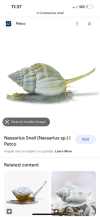Hey all,
I'm slowly stumbling my way through getting nassarius (Nassarius distortus) snails to settlement at the moment in a sketchy bucket in my living room. It'll likely be a long process because I haven't found any literature documenting breeding this particular species, but I thought it might be interesting to share on here! I have a thread going on Humblefish, but wanted to share it directly with Bay Area peeps, too.
I'm about 5 days post-hatch now, so will paste in a bunch of stuff I posted there to get you up to speed so that you may watch me fail, try again -- and likely fail again -- in realtime.
Unlike trochus snails, which sometimes settle and grow in aquaria, nassarius snails have a pretty long planktonic larval period (weeks to months) and need to eat a mix of foods as tiny, swimming larval veligers, so they need a special larval grow-out tank.
I'm using this paper as a reference for larval development, but it's a temperate species (Nassarius reticulatus) so I'm hoping everything goes faster in warm water. So far, the egg hatching period has been much faster (~3 days vs. 9-15 days).
Here's the culture vessel setup I'm using. It's pretty barebones, but I want to see if I can make it work with something simple before making it needlessly complicated.
It's a 2 gallon bucket (with a DIY acrylic lid to let ambient light in) nested inside of a 5 gallon bucket. The outer bucket contains a heater, filter floss seeded in my reef tank, a bag of carbon, and a rigid airline for aeration.
The inner bucket has holes around the entire upper perimeter at waterline with 75 micron mesh siliconed onto them. A very squeaky old Jebao doser pumps water from the outer bucket into the inner bucket every hour and slowly changes out the water in the inner bucket with the "filtered" water in the outer bucket. This setup keeps the delicate larvae away from the heater, filter floss, and carbon bag. I'm using a dosing pump instead of a regular pump because too much flow into the inner bucket will push the larvae into the mesh screens, damage them, and also will reduce the concentration of suspended food.
To start, I scraped freshly-deposited nassarius eggs off the back wall of my reef tank with a razor blade, put them in the inner bucket, and waited a few days...
I'm slowly stumbling my way through getting nassarius (Nassarius distortus) snails to settlement at the moment in a sketchy bucket in my living room. It'll likely be a long process because I haven't found any literature documenting breeding this particular species, but I thought it might be interesting to share on here! I have a thread going on Humblefish, but wanted to share it directly with Bay Area peeps, too.
I'm about 5 days post-hatch now, so will paste in a bunch of stuff I posted there to get you up to speed so that you may watch me fail, try again -- and likely fail again -- in realtime.
Unlike trochus snails, which sometimes settle and grow in aquaria, nassarius snails have a pretty long planktonic larval period (weeks to months) and need to eat a mix of foods as tiny, swimming larval veligers, so they need a special larval grow-out tank.
I'm using this paper as a reference for larval development, but it's a temperate species (Nassarius reticulatus) so I'm hoping everything goes faster in warm water. So far, the egg hatching period has been much faster (~3 days vs. 9-15 days).
Here's the culture vessel setup I'm using. It's pretty barebones, but I want to see if I can make it work with something simple before making it needlessly complicated.
It's a 2 gallon bucket (with a DIY acrylic lid to let ambient light in) nested inside of a 5 gallon bucket. The outer bucket contains a heater, filter floss seeded in my reef tank, a bag of carbon, and a rigid airline for aeration.
The inner bucket has holes around the entire upper perimeter at waterline with 75 micron mesh siliconed onto them. A very squeaky old Jebao doser pumps water from the outer bucket into the inner bucket every hour and slowly changes out the water in the inner bucket with the "filtered" water in the outer bucket. This setup keeps the delicate larvae away from the heater, filter floss, and carbon bag. I'm using a dosing pump instead of a regular pump because too much flow into the inner bucket will push the larvae into the mesh screens, damage them, and also will reduce the concentration of suspended food.
To start, I scraped freshly-deposited nassarius eggs off the back wall of my reef tank with a razor blade, put them in the inner bucket, and waited a few days...
Last edited:


